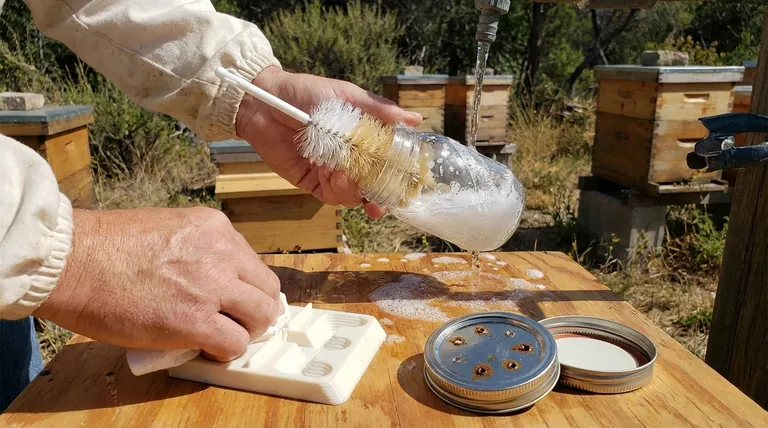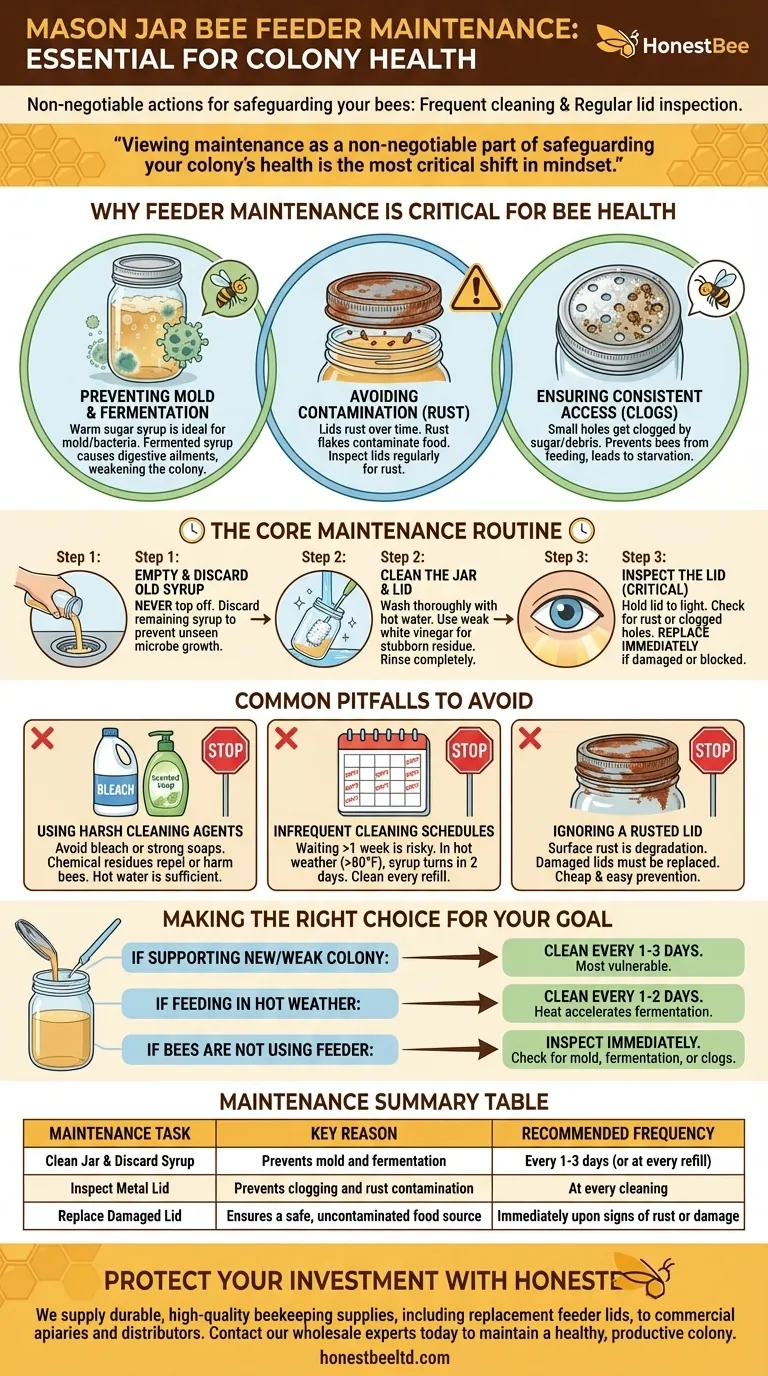The essential maintenance for a mason jar bee feeder involves two key actions: frequent, thorough cleaning of the jar and syrup, and regular inspection of the metal lid. Because sugar syrup can quickly grow mold or begin to ferment, the feeder must be cleaned every few days to protect your bees from disease. The lid's small holes are also prone to clogging or rusting, which can prevent bees from feeding or contaminate their food source.
A mason jar feeder is an effective tool, but it is not a "set and forget" solution. Viewing maintenance as a non-negotiable part of safeguarding your colony's health is the most critical shift in mindset for a beekeeper.

Why Feeder Maintenance is Critical for Bee Health
A clean feeder is a safe feeder. Neglecting this simple task can introduce significant risks to the very bees you are trying to help.
Preventing Mold and Fermentation
Sugar syrup, especially in warm weather, is an ideal growth medium for mold, bacteria, and yeast. When bees consume fermented syrup or water contaminated with mold, it can cause dysentery and other digestive ailments, weakening the entire colony.
Avoiding Contamination
As noted in the reference materials, metal lids are a primary point of failure. Over time, the acidic nature of the sugar syrup and environmental moisture can cause the lids to rust. This rust can flake off into the syrup, contaminating the bees' food supply.
Ensuring Consistent Access to Food
The small holes in the feeder lid are easily clogged by crystallized sugar, dead bees, or other debris. A clogged feeder can prevent the colony from accessing the food, leading to starvation, especially during critical periods when natural nectar is scarce.
The Core Maintenance Routine
Integrate this routine into your regular hive inspections. It should only take a few minutes and pays significant dividends in colony health.
Step 1: Empty and Discard Old Syrup
Never top off an old batch of syrup. Always discard any remaining syrup from the feeder, as it may have already started to ferment or grow microbes you cannot see.
Step 2: Clean the Jar and Lid
Wash the jar and lid thoroughly with hot water and a bottle brush. For stubborn residue, you can use a weak solution of white vinegar and water, but be sure to rinse it completely.
Step 3: Inspect the Lid
This is the most critical step. Hold the lid up to the light to ensure all holes are clear. Check for any signs of rust or damage. If you see significant rust or cannot clear the holes, discard the lid and replace it.
Common Pitfalls to Avoid
Even with good intentions, beekeepers can make simple mistakes that compromise the safety of their feeders.
Using Harsh Cleaning Agents
Avoid using bleach or strong, scented soaps. Bees are extremely sensitive to chemical residues and strong odors, which can repel them from the feeder or cause them direct harm. Hot water is almost always sufficient.
Infrequent Cleaning Schedules
Waiting a week or more between cleanings is a significant risk. In hot climates (above 80°F / 27°C), syrup can turn in as little as two days. A good rule of thumb is to clean the feeder every time you refill it.
Ignoring a Rusted Lid
A little surface rust might seem harmless, but it's a sign of degradation. A damaged lid should be replaced immediately. They are inexpensive and readily available, making it an easy way to prevent potential harm to your bees.
Making the Right Choice for Your Goal
Your cleaning frequency and inspection vigilance should match the specific needs of your colony and your environment.
- If your primary focus is supporting a new or weak colony: Clean and refill the feeder every 1-3 days, as these colonies are most vulnerable to disease and starvation.
- If you are feeding during hot weather: Clean your feeders every 1-2 days without fail, as high temperatures dramatically accelerate syrup fermentation.
- If you notice bees are not using the feeder: Your first action should be to pull the feeder and inspect it for mold, fermentation, or clogged holes.
Proper feeder maintenance is one of the simplest and most effective ways to demonstrate care for your bees.
Summary Table:
| Maintenance Task | Key Reason | Recommended Frequency |
|---|---|---|
| Clean Jar & Discard Syrup | Prevents mold and fermentation | Every 1-3 days (or at every refill) |
| Inspect Metal Lid | Prevents clogging and rust contamination | At every cleaning |
| Replace Damaged Lid | Ensures a safe, uncontaminated food source | Immediately upon signs of rust or damage |
Protect your investment and ensure your bees thrive with reliable equipment from HONESTBEE. We supply durable, high-quality beekeeping supplies and equipment, including replacement feeder lids, to commercial apiaries and beekeeping equipment distributors. Let us help you maintain a healthy, productive colony. Contact our wholesale experts today to discuss your needs!
Visual Guide

Related Products
- HONESTBEE Entrance Bee Feeder Professional Hive Nutrition Solution for Beekeeping
- Boardman Entrance Bee Feeder Durable Galvanized Steel and Wood Construction for Beekeeping
- HONESTBEE Professional Entrance Bee Feeder Hive Nutrition Solution
- Professional Hive Top Bee Feeder for Beekeeping
- HONESTBEE Professional Hive Top Bee Feeder Feeding Solution
People Also Ask
- How to make an entrance feeder for bees? A DIY Guide for Safe & Effective Feeding
- What is an entrance feeder? A Guide to Its Simple Design and High Robbing Risk
- How is the mesh ladder and barrier installed in the feeder box? A Step-by-Step Guide to Prevent Bee Drowning
- What are the common types of honey bee feeders? Choose the Right Feeder for Your Hive
- Are entrance feeders good for bees? Prioritize Hive Health Over Convenience



















